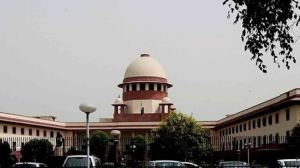‘Illegal hawkers’ livelihoods lost amid BMC crackdown, what’s the way forward?
The BMC also announced plans to hold elections to induct hawkers into the Town Vending Committee on Aug 29. Nayonika Bose examines the measures being taken by the BMC to address hawking and explores the broader implications of urban space regulation in Mumbai.
 Hawkers occupying footpaths areacommon sight inAndheri
East;(below) In Dadar East andWest, streetsare vendor-free,
ensuring smoothpassage formotoristsand pedestrians. (Express Photo by Sankhadeep Banerjee)
Hawkers occupying footpaths areacommon sight inAndheri
East;(below) In Dadar East andWest, streetsare vendor-free,
ensuring smoothpassage formotoristsand pedestrians. (Express Photo by Sankhadeep Banerjee)Hawkers, who sell everything from trinkets to food, have long been a crucial part of Mumbai’s economic landscape. Legally, the city has 10,360 licensed hawkers and 22,027 surveyed hawkers. However, the actual number, which includes unlicensed hawkers, is much higher, with hawker unions estimating it to be at least 300,000. A 1998 TISS-YUVA study had identified 102,401 hawkers occupying municipal lands in the city.
The lack of licences and designated spots often forces hawkers into high-density areas, such as streets outside railway stations, affecting pedestrians and motorists. Their unregulated presence on footpaths and roads exacerbates the strain on Mumbai’s already overwhelmed infrastructure.
Vidya Vaidya, a Bandra resident said, “Due to encroachments by hawkers on Hill road, residents are unable to traverse through the area as they even block the entrance to the main shops. It is so difficult to reach even the railway stations and last mile connectivity in the city has been severely impacted.”
To address these issues, the BMC is authorised under Section 314 of the Mumbai Municipal Corporation (MMC) Act to remove hawked goods and materials.
Senior officials report that the licence department conducts round-the-clock inspections in two shifts — morning and evening — across the city’s 24 wards to target illegal hawking in crowded areas.

 TVC information
TVC information
The BMC’s efforts include removing unlicensed encroachments and ensuring that licensed hawkers adhere to their designated areas. Over the past two years, the BMC has taken action against 337,000 hawkers, collecting Rs. 5.14 crore in penalties, auctions of goods, and redemption charges. This includes Rs 2.44 crore from actions against 164,847 unauthorised hawkers from June 2022 to May 2023. In the following year, from June 2023 to May 2024, penalties rose to Rs. 2.70 crore from the eviction of 172,523 hawkers.
Additionally, the BMC has penalised 198 licensed hawkers for operating outside their designated areas between January and May this year. This enforcement is part of a 2011 civic provision allowing the revocation of security deposits and issuance of show cause notices for licence abuse.
Despite these measures, the streets remain congested with hawkers, disrupting pedestrian and vehicular flow. In June, the Bombay High Court reprimanded the BMC for failing to curb the hawking problem on footpaths.
Following the court directive, Municipal Commissioner Bhushan Gagrani instructed strict action against unauthorised hawkers, encroachments and abandoned vehicles. The BMC intensified its eviction drive, collecting Rs 32.73 lakh in penalties from 9,417 hawkers in July 2024 alone.
At present, with 107 inspectors, the BMC plans to double this number with an additional 118 inspectors. A recent survey with police officials identified 20 congested areas prone to illegal hawking, where additional forces are now deployed for supervision during peak hours.
While space-starved residents have generally welcomed the increased enforcement, they call for stricter vigilance. The intensified anti-encroachment drive has left many hawkers in disarray, highlighting the ongoing challenges in balancing urban space regulation with the needs of street vendors.
Livelihoods lost
Nearly a month ago, Javed Shaikh’s vada pav stall in Masjid Bandar was evicted by civic and police authorities under court orders. Since then, Shaikh, 58, has lost his livelihood and accrued a debt of Rs 30,000.
Shaikh, who has been running his stall since 1998, said, “Despite having receipts from past surveys and operating within the designated hawking zone, my stall was removed by the police. I’ve been jobless ever since. With a family of four, we are facing severe hardships. I don’t know if I’ll ever be able to set up shop again.”
Shaikh is not alone. Many hawkers have faced action over the past month, with their livelihoods being significantly affected.
Some of these vendors, among the most vulnerable in the city’s informal sector, have reported instances of police harassment. Behru Hiralal Chaudhari, who operates an ice-cream shop near CST, said, “We not only face evictions but also have officials taking our goods without issuing receipts. We are willing to relocate to specific hawking zones, but this option hasn’t been offered. Nearly 100-150 vendors near CST alone have lost their jobs. With no means of earning, many, like my nephew who ran a food stall, have been forced to return to their villages.”
On July 18, hundreds of hawkers from across Mumbai and neighboring areas, including Mira-Bhayandar and Nashik, staged a protest at Azad Maidan. They called for the effective implementation of the Street Vendors Act of 2014, which was designed to protect the rights of urban street vendors and regulate their activities by creating designated hawking zones.
Urban planners also advocate for the establishment of specific hawking zones. They argue that such zones would allow vendors to operate in a regulated manner, preventing them from encroaching on public spaces and ensuring a more organised approach to street vending.
 On July 18, hundreds of hawkers from across Mumbai and neighboring areas, including Mira-Bhayandar and Nashik, staged a protest at Azad Maidan. (Express Photo by Ganesh Shirsekar)
On July 18, hundreds of hawkers from across Mumbai and neighboring areas, including Mira-Bhayandar and Nashik, staged a protest at Azad Maidan. (Express Photo by Ganesh Shirsekar)
TVC formation
In an effort to regulate hawking and develop specific street vending zones, the BMC is preparing to hold elections through which hawkers will be inducted to the Town Vending Committee (TVC) on August 29 — almost a decade after the Street Vendors (Protection of Livelihood and Regulation of Street Vending) Act, 2014 mandated their establishment. The TVCs are tasked with overseeing, managing street vending activities and finalising street vending zones.
Expressing dissatisfaction over the delay, the High Court directed the BMC on August 1 to complete the election by the end of August and to regulate street vending activities as per the Act by the end of September.
Speaking to The Indian Express, a senior official from the licence department said, “The BMC has identified hawking zones across the city. Once the committee is established, there will be discussions among the members regarding these designated zones, and an election will determine their final designation. Since the list of vending locations was identified some years ago, the committee may also address the issue of new spaces across the city.”
For now, the BMC has finalised 30,832 street vending places across 404 roads.
In 2014, the BMC conducted a survey distributing 128,000 applications and receiving 99,435 from hawkers. After scrutiny, the civic body finalised a list of 22,027 hawkers. Along with the previously licensed 10,000, only 32,407 hawkers are eligible to vote in the TVC elections.
“Following the elections, there will be one apex TVC and seven zonal TVCs, each comprising eight elected hawker members who will replace members from haw-ker unions,” the official added.
According to the Street Vendors Act, 40 per cent of each committee must be hawkers, with one-third of the members being women vendors, and representation for minority groups and persons with disabilities. On July 29, a lottery was held, in the presence of a returning officer appointed by the state labour commissioner, to select the eight women representatives for the committee.
Despite the TVC being a long-awaited demand from hawkers, the announcement of the election has faced criticism from several quarters.
Why TVC isn’t enough
Despite the formation of the Town Vending Committee (TVC), significant issues persist for Mumbai’s hawkers, primarily due to the limited list of eligible voters for the upcoming elections, which includes only 32,000 hawkers.
This restricted list means many hawkers will continue to face eviction until they obtain licences and certificates, even if designated street vending zones are established.
Shashank Rao of the Mumbai Hawkers’ Union, who has opted not to participate in the elections, argues, “The election is being held for just 32,000 hawkers, while the actual number is close to 300,000. What about the others? What’s the point of such an election?”
Rao also highlights the discrepancy with the Pradhan Mantri Street Vendor’s AtmaNirbhar Nidhi (PM SVANidhi) scheme, noting, “Following Covid-19, the BMC issued Letters of Recognition (LOR) to nearly 180,000 hawkers who were seeking loans under SVANidhi, with about 100,000 to 130,000 already having received these loans. If the BMC has identified over 100,000 hawkers through this scheme, why are only 32,000 recognised as eligible voters? The Act allows for hawking licenses to be issued to 2.5 per cent of the population. This situation mocks the system.”
Senior civic officials responded that the criteria for SVANidhi eligibility differ from those used for the TVC elections, which is why they have not been applied in this context.
Additionally, the abrupt announcement and rushed organisation of the elections have raised further concerns. Dayashankar Singh, president of the Azad Hawkers’ Union, said, “After the HC cracked its whip, the BMC has now announced the elections in a rush. Since it’s being organised in such an abrupt manner, hawkers don’t even have the time to understand the procedure. Most hawkers don’t know where and how to vote nor do they know what documents they have to provide to be able to cast votes.”
“Even the hawkers who have availed loans under SVANidhi and were provided with provisional certificates have been told that these documents will not enable them to participate,” added Singh.
 Hawkers occupy the streets in Andheri. (Express Photo by Sankhadeep Banerjee)
Hawkers occupy the streets in Andheri. (Express Photo by Sankhadeep Banerjee)
The way forward
With hawkers as well as citizens unlikely to reap any real benefits from the civic body’s TVC plans, hawkers have aired the need for licensing as well as better planning in the city.
The long term solution for improving security among the street vendors, according to Shashank Rao, lies in issuing more licences. He said, “Each time the HC issues directives, the BMC starts increasing demolitions. The hawkers are always living in fear of eviction and losses. To improve security, the BMC should start issuing licences to more eligible hawkers. However, they don’t do so since they will lose out on their hafta, which earns them crores of money.”
Meanwhile, residents have welcomed the elections. Chairman of Bandra Reclamation Area Volunteers Organization (BRAVO), which had been instrumental in taking the issue of hawkers to the High Court, Vidya Vaidya added, “Once the committee is formed, the work on implementing the street vending policy can move forward. Mumbai is a vertical city and the roads have limited capacity. We need to take stricter stance against the hawking menace.”
With the city now moving forward towards the development of hawking zones, city architects have pointed to the economics of demand to ensure long-term success in the project. According to urban planners such as Vivek Pai, special attention must be paid to ensure that the designated hawking spaces are developed in locations that are accessible to buyers, where they can easily walk and purchase from the hawkers.
Pai said, “Hawkers are always evaluating the most appropriate location for business and they position themselves on the basis of where people are most likely to visit and purchase from them. If they see that people’s demand is less, they relocate to another place.”
Pai added that if hawker zones are made at inaccessible locations, people are unlikely to visit and buy from these designated market spaces and the hawkers will end up relocating back to their original locations on the streets.







